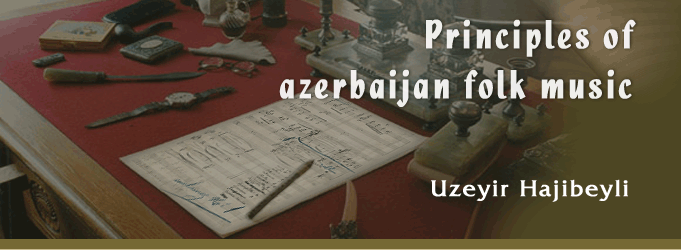

Part one
MAIN PRINCIPLES
II. WAYS OF TETRACHORDS COMBINING
Scales of Azerbaijani modes are structured by combination of tetrachords, represented in succession of 4 diatonic degrees.
Tetrachords within perfect quartes are called perfect.
Tetrachords within increased quartes are called increased.
Tetrachords within diminished quartes are called diminished.
Tetrachords can be combined in 4 ways:
1-st way - chain combination, i.e. a combination where the last tone of the lower tetrachord coincides with the first tone of the upper tetrachord. An interval formed is a perfect prima. In the manuals on music theory such combinations are called conjoint ones.
2-nd way - mixed combination, i. e. a combination where the last tone of the lower and the first tone of the upper tetrachords form the interval of the major second which is called separate combination.
3-rd way - combination by intermediate semitone, i.e. a combination where an interval of the minor third is formed between the last tone of the lower and the first tone of the upper tetrachords.
4-th way - combination by intermediate tone, i. e. a combination where an interval of the major third is formed between the last tone of the lower and the first tone of the upper tetrachords.
Combined or joined tetrachords can be equal or unequal by their structure.
Combination of equal tetrachords forms consequent succession of degrees in the order of scales. When the 1-st way of combination is applied to perfect tetrachords, identical in structure, it forms a scale consisted of gradual succession of perfect quartes.For example:
When the 2-nd way of combination is applied to perfect tetrachords, equal in their structure, it forms a scale consisted of gradual succession of perfect quintes:
When the 3-rd way of combination is applied to perfect tetrachords of similar structure, it forms a scale consisted of gradual succession of minor sixths:
When the 4-th way of combination is applied to perfect tetrachords, likewise of identical structure, it forms a scale consisted of gradual succession of major sixths:
The above given tetrachords in the examples 12, 13, 14, and 15, structured by formula 1 - 1 - 1/2 , i. e. tone-tone-semitone, are considered main tetrachords, the 1-st and 4-th degrees are considered the main tones.
[ MAIN PRINCIPLES: page 1 2 3 4 5 6 7 ]



